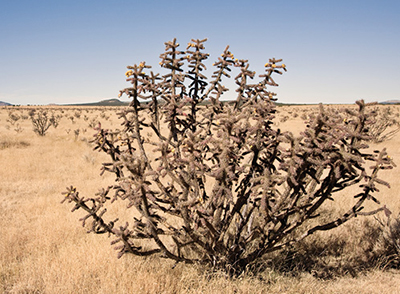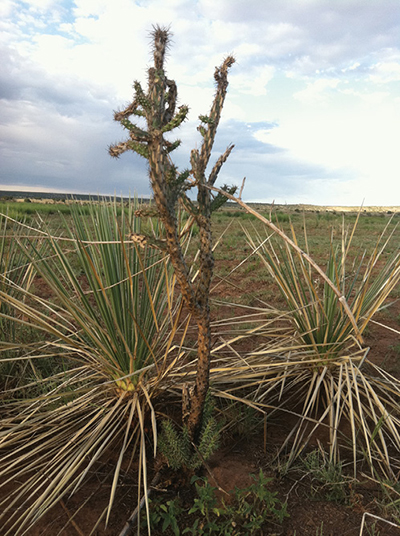Control Cholla Cactus
Guide B-804
College of Agricultural, Consumer and Environmental Sciences, New Mexico State University
Revised by Kert Young and Doug Cram
Authors: Respectively, Extension Brush and Weed Specialist and Assistant Professor/Extension Forestry and Fire Specialist, Department of Extension Animal Sciences and Natural Resources, New Mexico State University. (Print Friendly PDF)
Cholla, often called tree cactus, walkingstick cholla, or cane cactus, is widely distributed throughout most areas of New Mexico. It is a tree-like plant growing to 8 ft tall with cylindrical joints 1 in. in diameter and 3–5 in. long. Spines are numerous and about 1 in. long. Cholla flowers are purple and mature into yellow fruit. The fruit drops to the ground when ripe, producing new plants. Cholla also can reproduce from terminal joints that fall to the ground and root when moisture is available.
Cholla often becomes a problem on rangeland when the grass cover is depleted by drought and over-utilization. After establishment, the cactus encroaches upon valuable range until dense thickets develop. These thickets hinder livestock operations and compete with needed forage for moisture and nutrients. Thick stands often result in livestock becoming “cholla eaters.”

Mechanical Control Methods
Hand Grubbing
You can control cholla easily by “grubbing” with a pick mattock. Cut the main root 2–4 in. below the ground level and remove the plant from the area. If you clear the area carefully, regrowth should be confined to young plants not yet visible. Pile the grubbed plants and let them dry. Don’t scatter broken joints because sprouting may occur. Prevent sprouting around the piled cholla by burning the piles when dry. Grubbing during winter or drought years reduces re-infestation from scattered joints.
Mechanical Grubbing
You can mechanically uproot cholla plants by mounting a toothed fork on a front-end loader of a tractor. Slip the fork under the plant and gently lift until the cactus is uprooted. The bucket should be tilted to catch as many of the broken joints as possible. Two or three plants can be uprooted before dumping.
Mechanical grubbing is not always successful because heavy re-infestation may occur if the tractor operator is not careful. When lifting the cholla from the soil, don’t scatter the joints. Choose the best year for grubbing to allow the greatest chance for success. The cactus is more likely to dry if grubbed in December or January or in droughty summers.
Chemical Control Methods
Precautions
Follow directions on the USDA-approved labels on the container to prevent danger from chemical residue. Avoid drift to foliage of nearby susceptible crops. Do not spray when wind speed is high. Do not use the same equipment to apply insecticides on crop plants, flowers, or vegetables.
Recommended Solutions
Foliage spray. Excellent results have been obtained from a solution of one part 2,4-DP, three parts diesel oil, and 20 parts water. Kills range from 95–100%. The number of gallons of mix will vary with the density and size of the plants, but 1 gallon usually covers 14–20 plants.
A spray mixture of 16 oz of picloram (Tordon 22k), 4 oz of wetting agent, and 50 gallons of water has also given good results. Plants may not actually die for one or two years after spraying.
A combination of picloram and fluroxypyr (Surmount) mixed with wetting agent and water at a rate of 1–2 gallons of herbicide per 100 gallons of water also effectively controls cholla.
Basal treatment. Undiluted picloram1 can be applied to the base of cholla near the ground line using 4–6 mL of product per 3 ft of plant height. Undiluted hexazinone (Velpar) at the same application rate will give similar control results.
Method of Application
Foliage spray. Hand application of herbicide solutions with knapsack, compression tank-type, or power sprayer is most effective for cholla control. Use a nozzle pressure of 25–35 lb for hand sprayers and 40 lb for power sprayers. A coarse spray (large droplets) is more desirable than mist-like fogs for covering cholla. Wet the plant thoroughly on all sides, joints, base, and trunk to the point of slight runoff for effective kill.
In dense stands, power sprayers have some added advantages over hand-sprayers: They can be pulled or carried by a truck or tractor, refilling the sprayer is not required as often, and several operators can work from one tank by attaching additional lead hoses and nozzles.
Power sprayers work well if the infested area is relatively smooth and not brushy. Hand-type sprayers can be used in any terrain and are often used to supplement power sprayers.
Basal treatment. Undiluted herbicide should be applied with a metered hand gun set to deliver 4–6 mL of product at the junction of the main stem near the ground surface. Precipitation helps move the herbicide through the soil to the roots, and cholla are very slow to show effects (2–3 years).
Time of Application
Apply spray solutions to cholla as soon as new growth becomes visible in May, and when temperatures are about 60°F. Plants in bloom are preferred for treatment. Allow two growing seasons for evaluation.
Management Following Control
Follow cholla control with good range management. Cholla control may not mean increased livestock numbers in the future, only an increase in usable forage supply for the livestock on hand. Don’t expect large forage increases, but livestock handling should be easier.
Fire Control Methods
In some cases, cholla can be controlled with fire. Plant height is the most important factor to consider, followed by fuel loading (Figure 1). Dwyer and Pieper (1967) reported excellent control when plants were less than or equal to 6 in. in height. Plants 6–12 in. in height were also killed, but at a rate of only 50%. Cholla taller than 1 ft were unaffected by fire. These results were achieved at Fort Stanton, NM, with a spring fire that burned blue grama grasslands with a fuel load measured at 738 pounds per acre (lb/ac).

Figure 1. Cholla plant that was damaged by prescribed fire but not killed. This cholla was not a good candidate for burning because its height was greater than 6–12 in., there is a lack of fine fuel surrounding the base of the plant, and there is resprouting at the base. (Photo by Doug Cram.)
Parmenter (2008) also reported greater mortality on shorter cholla plants, with 22 in. being the breakpoint. However, this was achieved in the summer at the Sevilleta National Wildlife Refuge, NM, burning ungrazed rangelands supporting 1,700 lb/ac of fuel and producing 6-ft flame lengths. Fire severity was characterized as severe on all plants. This fire resulted in 64% mortality on cholla three months after fire and 89% mortality after five years. Also, recovery of damaged plants was slowed for up to 12 years.
Time since burning must be considered when evaluating cholla mortality following fire (Cave and Patten, 1984). Heirman and Wright (1973) reported 15% mortality on cholla less than 1 ft in height after one growing season following fire, but 48% by the middle of the second growing season following fire. Mortality on cholla greater than 1 ft was 0% and 4% in the first and second seasons after burning, respectively. This was achieved in West Texas burning 1,200 lb/ac of buffalograss in the spring. Likewise, burning 4,300 lb/ac of tobosagrass in the same area resulted in 33% and 81% mortality the first and second year following fire for cholla less than 1 ft, and 6% and 45% mortality, respectively, for cholla greater than 1 ft.
A reasonable management recommendation would be to burn in the spring or summer with as much fuel as possible with the expectation that cholla less than 1 ft tall will experience ~50% mortality by the end of the second growing season following fire. Nominal mortality should be expected on cholla taller than 1 ft, with slightly greater mortality in cases with substantial fuel loads.
Literature Cited
Cave, G., and D. Patten. 1984. Short-term vegetation responses to fire in the upper Sonoran Desert. Journal of Range Management, 37, 491–496.
Dwyer, D., and R. Pieper. 1967. Fire effects on blue grama-pinyon-juniper rangeland in New Mexico. Journal of Range Management, 20, 359–362.
Heirman, A., and H. Wright. 1973. Fire in medium fuels of west Texas. Journal of Range Management, 26, 331–335.
Parmenter, R. 2008. Long-term effects of a summer fire on desert grassland plant demographics in New Mexico. Rangeland Ecology and Management, 61, 156–168.
Brand names appearing in publications are for product identification purposes only. No endorsement is intended, nor is criticism implied of similar products not mentioned. Persons using such products assume responsibility for their use in accordance with current label directions of the manufacturer.
The pesticide recommendations in this publication are provided only as a guide. The authors and New Mexico State University assume no liability resulting from their use. Please be aware that pesticide labels and registration can change at any time; by law, it is the applicator’s responsibility to use pesticides ONLY according to the directions on the current label. Use pesticides selectively and carefully and follow recommended procedures for the safe storage and disposal of surplus pesticides and containers.
1Use of picloram is restricted. Ask your county Extension agent (https://aces.nmsu.edu/county/) for information on current regulations.
For further reading
B-806: Brush and Weed Control on New Mexico Ranges
https://pubs.nmsu.edu/_b/B806/
CR-374: New Mexico Range Plants
https://pubs.nmsu.edu/_circulars/cr-374/
CR-649: Developing a Grazing System for Arid Climates
http://pubs.nmsu.edu/_circulars/cr-649/

Kert Young is an Extension Rangeland Brush and Weed Specialist at NMSU. He has experience controlling invasive plants with mechanical, chemical, cultural, and other techniques. His Extension and research work helps the people of New Mexico understand how to manage invasive plants and repair damaged range and pasture lands, and benefits land condition, productivity, sustainability, and profitability for an improved quality of life for New Mexicans.
To find more resources for your business, home, or family, visit the College of Agricultural, Consumer and Environmental Sciences on the World Wide Web at pubs.nmsu.edu
Contents of publications may be freely reproduced for educational purposes. All other rights reserved. For permission to use publications for other purposes, contact pubs@nmsu.edu or the authors listed on the publication.
New Mexico State University is an equal opportunity/affirmative action employer and educator. NMSU and the U.S. Department of Agriculture cooperating.
Revised January 2018 Las Cruces, NM


